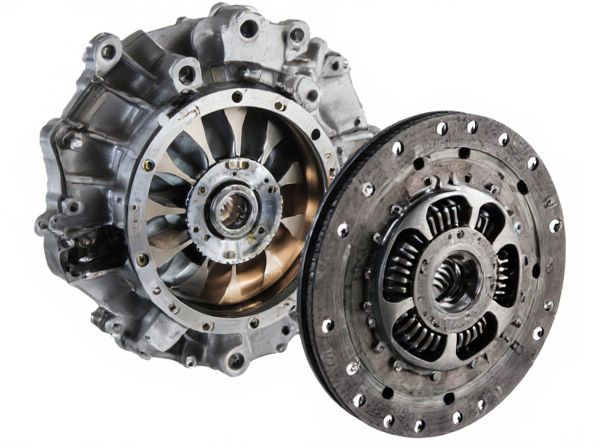
Photo illustration: Electromagnetic clutch vs Hydraulic clutch
Electromagnetic clutches engage and disengage power transmission using an electric current, offering precise control and quick response times ideal for automation applications. Hydraulic clutches rely on fluid pressure to transfer torque, providing smoother engagement and greater force capacity suited for heavy-duty machinery. Your choice depends on the required response speed, control precision, and load handling in your specific system.
Table of Comparison
| Feature | Electromagnetic Clutch | Hydraulic Clutch |
|---|---|---|
| Operation | Uses electric current to engage/disengage clutch | Uses hydraulic fluid pressure to control clutch |
| Response Time | Fast and precise | Moderate, dependent on fluid dynamics |
| Maintenance | Lower maintenance, no fluid leaks | Requires fluid checks and possible bleeding |
| Durability | Long-lasting with proper electrical system | Potential wear due to fluid contamination |
| Cost | Higher initial cost due to electronics | Generally lower upfront cost |
| Application | Common in modern automatic transmissions, hybrid vehicles | Widely used in manual transmissions and older automatics |
Introduction to Clutch Systems
Electromagnetic clutches use an electromagnetic field to engage and disengage the driven component, offering precise control and rapid response ideal for applications requiring frequent start-stop operations. Hydraulic clutches rely on fluid pressure to transfer torque, providing smooth engagement and superior torque capacity suited for heavy-duty machinery and vehicles. Both clutch systems are essential in mechanical power transmission, with electromagnetic clutches excelling in automation environments and hydraulic clutches preferred in high-load, high-torque scenarios.
What is an Electromagnetic Clutch?
An electromagnetic clutch uses an electric current to create a magnetic field that engages or disengages the clutch mechanism, allowing torque transmission between shafts without direct mechanical linkage. It offers rapid response times and precise control, making it ideal for applications requiring frequent or automated clutch operation. Compared to hydraulic clutches, electromagnetic clutches provide cleaner operation with less maintenance since they do not rely on fluid pressure or hydraulic components.
What is a Hydraulic Clutch?
A hydraulic clutch uses fluid pressure to transfer power from the engine to the transmission, offering smoother and more precise engagement compared to mechanical clutches. It consists of a master cylinder, slave cylinder, and hydraulic fluid, enabling efficient force multiplication and reducing pedal effort. Hydraulic clutches are preferred in modern vehicles for their reliability, ease of maintenance, and consistent performance under varying conditions.
Working Principle: Electromagnetic vs Hydraulic
Electromagnetic clutches operate using an electric current to generate a magnetic field that engages the clutch plates, allowing torque transmission without direct mechanical connection. Hydraulic clutches rely on fluid pressure generated by a master cylinder to actuate the clutch mechanism, providing smooth engagement through hydraulic force. The electromagnetic system enables rapid response and precise control, while hydraulic systems offer consistent force application and self-adjustment for wear.
Key Components Comparison
Electromagnetic clutches utilize an electromagnetic coil, armature, and rotor to engage and disengage the drive, enabling quick response and precise control in applications such as automotive and industrial machinery. Hydraulic clutches rely on hydraulic fluid pressure, a master cylinder, and a slave cylinder to transmit force, offering smoother engagement and higher torque capacity suitable for heavy-duty vehicles and equipment. The electromagnetic clutch's key components emphasize electrical activation, while the hydraulic clutch depends on fluid dynamics and mechanical linkages for operation.
Performance and Efficiency Analysis
Electromagnetic clutches offer faster response times and precise engagement due to their electric actuation, delivering superior performance in applications requiring frequent start-stop cycles. Hydraulic clutches provide smoother torque transfer and higher torque capacity, making them ideal for heavy-duty operations but with increased energy consumption due to fluid dynamics. Electromagnetic clutches demonstrate higher energy efficiency with lower power loss, whereas hydraulic systems tend to suffer from fluid friction and heat dissipation, reducing overall efficiency.
Maintenance and Durability
Electromagnetic clutches offer lower maintenance requirements due to their simpler design with fewer moving parts, reducing wear and tear compared to hydraulic clutches that rely on fluid pressure and seals prone to leakage and contamination. Hydraulic clutches generally provide smoother torque transfer and better heat dissipation but require regular fluid checks, bleeding, and seal replacements to maintain durability. Electromagnetic clutches excel in applications demanding precise engagement and long service life with minimal downtime, whereas hydraulic clutches are favored for high-torque environments despite their higher maintenance needs.
Application in Automotive and Industrial Sectors
Electromagnetic clutches offer rapid engagement and precise control, making them ideal for automotive applications such as air conditioning compressors and automated transmissions, where quick response and energy efficiency are critical. Hydraulic clutches provide robust torque transfer and smooth operation under heavy loads, commonly used in industrial machinery and heavy vehicles requiring high durability and consistent performance. Both clutch types enhance mechanical system reliability but are chosen based on specific operational demands, with electromagnetic clutches favored for quick switching and hydraulic clutches preferred for heavy-duty power transmission.
Pros and Cons of Electromagnetic Clutches
Electromagnetic clutches offer rapid engagement and disengagement, precise control, and reduced wear due to the absence of mechanical linkages, making them ideal for applications requiring frequent cycling and automation. However, their reliance on electrical power can lead to performance issues during power failures, and they typically generate more heat, necessitating efficient cooling systems. Unlike hydraulic clutches that provide smoother operation through fluid pressure, electromagnetic clutches may suffer from limited torque capacity and higher energy consumption.
Pros and Cons of Hydraulic Clutches
Hydraulic clutches offer smooth and precise engagement, reducing driver fatigue and enabling better control in variable driving conditions. They require less physical effort compared to mechanical clutches, but their complexity involves higher maintenance costs and potential fluid leaks that can impair performance. Despite these drawbacks, hydraulic clutches provide improved modulation and consistent pedal feel, making them favorable for heavy-duty and performance vehicles.
 caratoz.com
caratoz.com